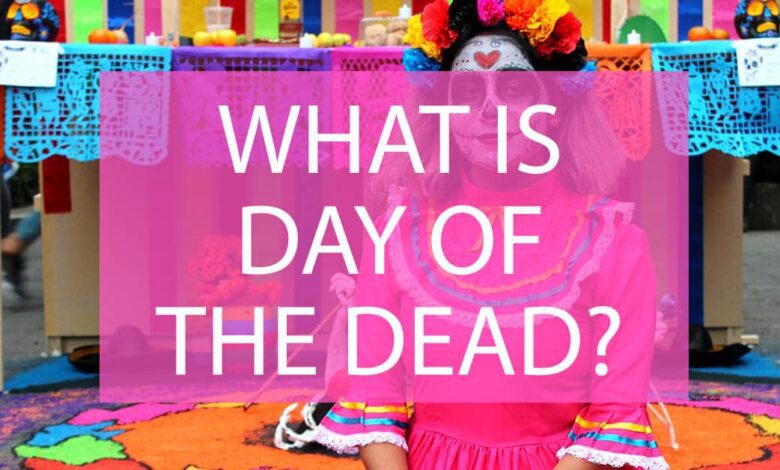What is Day of the Dead and how is it celebrated?

What is Day of the Dead?
The Day of the Dead is one of the most observed days in Mexican culture. It is usually observed by Mexicans and people of Mexican descent living in other countries on November 1.
This day celebrates the lives of the dead, who are believed to return to life within a day. The festival honors their memories with parades, readings, and parties. Also, people also dress in costumes that resemble skeletons or calacas. These are figures associated with death who are often depicted wearing elaborate clothing or jewelry.
Day of the Dead, A Celebration for the Lost
The Day of the Dead, or Dia de los Muertos, is an important celebration in Mexican culture. It happens every year on the 1st and 2nd of November. The departed are honored with a celebration.
Day of the Dead celebrations are celebrated throughout Mexico and in other areas around the world with significant Mexican influence such as Canada, the US, Chile and Spain. The celebrations follow different traditions but all of them include food for the living and offerings for both children and adults who have died. The celebration also includes altars with favorite foods, drinks or things important to the deceased.
Different communities follow different traditions to honor their loved ones who have crossed over to the spirit realm. Some traditions include sweeping the graves before dawn on November 1st, singing
How is the Day of the Dead celebrated?

The Day of the Dead is not only celebrated in Mexico but also in other parts of Latin America. There are different ways to celebrate this day, for example with traditional foods such as sugar skulls and pan de muerto.
This holiday is a celebration of the lives of people who have died in the past year. Families will clean and decorate the graves of their loved ones. Some will hold mass in their honor. And others will celebrate with festive food and music.
The celebration usually begins with a ritual called “Las Ofrendas”. This is where people decorate and make offerings for their deceased relatives and friends.
On November 1, people gather at cemeteries and light candles in honor of the dead. On November 2, there are parties and festivities throughout the day to celebrate the lives of those who died.
What is Los Dias de los Muertos?
‘Los Dias de los Muertos’ is the Spanish phrase for Day of the Dead. This is a Mexican tradition that dates back to pre-Hispanic times. When they believed that people went from Earth to another world. The living will visit cemeteries on November 1st. And they would leave gifts for the souls of their loved ones there.
Like other holidays, people celebrate the Day of the Dead with food, decorations, and costumes.
What is pan de muerto?
Pan de muerto is a Mexican delicacy made with sugar and egg yolks.
Usually it is made in a bread shape.
It is traditionally eaten every November 1st to remember those who have passed away throughout the year. It can also be eaten on All Saint’s Day (November 2) and All Soul’s Day (November 2).
According to popular belief, it tastes like the sweet bread of heaven.
How is the Day of the Dead celebrated around the world?

The Day of the Dead is one of the most important celebrations in Mexico, but it has become an international holiday.
For example, Brazilians celebrate Dia dos Mortos to remember lost loved ones. China celebrates Tomb Sweeping Day on April 5th to honor their ancestors. And Korea honors their dead by visiting graves and putting out food for them.
In some Central American countries such as Honduras, El Salvador, Guatemala and Nicaragua, the Day of the Dead is influenced by Catholic customs from Spain. The celebration is more sombre in nature. This results in a more solemn celebration.
The Day of the Dead commemorates lost friends and family members by praying for their souls to find peace. Some people even believe that if they do not pray for their loved ones on this particular day, the souls will wander the Earth forever.
Dia de los Muertos costumes
Day of the Dead costumes are commonly associated with Halloween, but their origins are actually related to the annual Mexican holiday that honors deceased family members.
Costumes for Dia de Los Muertos are traditionally decorated with skulls, sugar skulls, marigolds, cempasuchil flowers and papel picado banners with greetings for the dead. They are intended to be an offering to help guide the departed on their journey to the afterlife.
Usually, the costume consists of a sugar-skull makeup, or calavera makeup. It is a flawless face with exaggerated eye sockets and cheekbones. Additionally, traditional Day of the Dead costumes include adornments such as flowers and ribbons in Mexico’s national colors; green, white and red.
Typically, the custom in Mexico is to dress to show your respect for others who have passed away by wearing the clothes you think they would have wanted you to wear. It not only serves as a way for people to remember the departed but it also helps them get over their grief.
The Meaning Behind the Colors on Day of the Dead

Bright colors, sugar skulls, and marigolds are often found in Day of the Dead decorations. All of these are representative of the sugarcane industry in Mexico during the colonial period.
Sugar skulls made from ground-up cane stalks, are placed on altars to represent the deceased. The shape of the skull is believed to have originated in the temples of indigenous people in central America, where human skulls were displayed.
Day of the Dead Final Note
Above all, the holiday focuses on gatherings of family and friends to remember the dead. In conclusion, the Day of the Dead is a popular holiday that celebrates life through various traditions. And it is an opportunity to remember and reflect on loved ones who have been lost.






